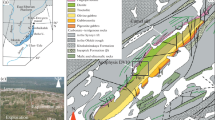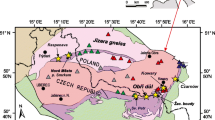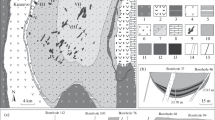Abstract.
The massive sulfide deposits of the Kristineberg area, Sweden, occur within a 2- to 3-km-thick succession of felsic volcaniclastic rocks belonging to the Skellefte Group. The volcanic pile is intruded by a synvolcanic Jorn-type granitoid (Viterliden intrusive complex) and is overlain by a thick sequence of metasedimentary rocks (Vargfors Group). Mineralization occurs at two main stratigraphic levels, at the base of the felsic volcanic succession and at the contact with the metasedimentary rocks of the Vargfors Group. The Kristineberg Cu–Zn mine is the largest deposit (approximately 21 Mt) and occurs at the base of the volcanic pile, close to the contact with the Viterliden intrusive complex. Four smaller deposits (Ravliden, Ravlidmyran, Horntrask and Nyliden) occur along the upper ore horizon. These deposits are thought to be related to a late intrusive phase of the Viterliden complex which cuts the altered volcanic rocks at the Kristineberg deposit. Within an area of about 50 km2 surrounding the Kristineberg deposit, felsic volcanic rocks between the two ore horizons are affected by extensive albite-destructive alteration (sodium depletion) and development of chlorite and muscovite (strong co-enrichment in magnesium and potassium). The Kristineberg deposit is enveloped by a large and partly transposed quartz–chlorite alteration zone, approximately 2 km in diameter, and a distal but coherent pyrite–quartz–muscovite alteration zone extending as far as 4 km from the deposit. Chlorite(±talc) in the mine area is notably magnesium-rich and contains anomalous F, Ba, Zn and Mn. High fluorine is also present in coexisting muscovite and phlogopite. The magnesium-rich chlorite alteration contrasts sharply with the iron enrichment observed in many other felsic, volcanic-hosted Precambrian massive sulfide deposits. This may indicate fixation of iron by large amounts of pyrite in the section or entrainment of large amounts of seawater in the hydrothermal upflow zones. Kyanite is developed locally in the chlorite-rich pipe at Kristineberg in response to regional thermal metamorphism of highly aluminous alteration in the immediate foot-wall rocks. Spectacular, andalusite-bearing quartz–muscovite schists and quartz–biotite–cordierite schists also occur where the altered felsic volcanic rocks are intruded by the late Revsund granite. However, similar metamorphic mineral growth is not observed where the volcanic rocks at the contact are less altered. Deposits near the top of the felsic volcanic succession are characterized by magnesium-rich chlorite alteration in the foot wall and proximal calc-silicate assemblages (dolomite, calcite, tremolite, ±garnet, ±margarite) where the host sedimentary rocks are carbonate-rich. In general, the calc-silicate alteration is restricted to the immediate hanging wall and zones lateral to the deposits and does not represent a regionally extensive exploration target. The two main ore horizons in the Kristineberg area are not linked by any obvious discordant structures or alteration zones. However, mineral-chemical studies highlight several possible fluid flow pathways leading from the Kristineberg deposit to the Ravliden ore horizon, more than 2 km upsection. Overprinting regional metamorphic minerals have inherited the hydrothermal signature of the ore-related alteration. Electronic Supplementary Material is available at http://dx.doi.org/10.1007/s00126-002-0299-y. On that page (frame on the left side), a link takes you directly to the supplementary material.















Similar content being viewed by others
References
Aggarwal PK, Nesbitt BE (1984) Geology and geochemistry of the Chu Chua massive sulfide deposit, British Columbia. Econ Geol 79:815–825
Allen RL, Weihed P, Svensson S-A (1996) Setting of Zn-Cu-Au-Ag massive sulfide deposits in the evolution and facies architecture of a 1.9 Ga marine volcanic arc, Skellefte District, Sweden. Econ Geol 91:1022–1053
Bergman-Weihed J, Bergström U, Billström K, Weihed P (1996) Geology, tectonic setting, and origin of the Paleoproterozoic Boliden Au-Cu-As deposit, Skellefte District, Northern Sweden. Econ Geol 91:1073–1097
Brauhart CW, Groves DI, Morant P (1998) Regional alteration systems associated with volcanogenic massive sulfide mineralization at Panorama, Pilbara, Western Australia. Econ Geol 93:292–303
Brauhart CW, Huston DL, Groves DI, Mikucki EJ, Gardoll SJ (2001) Geochemical mass transfer patterns as indicators of the architecture of a complete volcanic-hosted massive sulfide hydrothermal alteration system, Panorama District, Pilbara, Western Australia. Econ Geol 96:1263–1278
Bucher K, Frey M (1994) Petrogenesis of metamorphic rocks. Springer, Berlin Heidelberg New York
Cathles LM (1993) Oxygen isotope alteration in the Noranda mining district, Abitibi greenstone belt, Quebec. Econ Geol 88:1483–1511
Costa UR, Barnett RL, Kerrich R (1983) The Mattagami Lake Mine Archean Cu-Zn sulfide deposit, Quebec: Hydrothermal coprecipitation of talc and sulfides in a sea-floor brine pool – evidence from geochemistry, 18O/16O, and mineral chemistry. Econ Geol 78:1144–1203
Du Rietz T (1953) Geology and ores of the Kristineberg deposit, Vesterbottn, Sweden. Svierge Geol Undersök Ser C 524 45(5)
Eastoe CJ, Solomon M, Walshe JL (1987) District-scale alteration associated with massive sulfide deposits in the Mount Read Volcanics, Western Tasmania. Econ Geol 82:1239–1258
Edelman N (1967) Stratigraphy and metamorphism in the Kristineberg area, northern Sweden. Svierge Geol Undersök Ser C 622 61(7)
Franklin JM, Kasarda J, Poulsen KH (1975) Petrology and chemistry of the alteration zone of the Mattabi massive sulfide deposit. Econ Geol 70:63–79
Grip E, Frietsch R (1973) Ores in Sweden. Part 2: northern Sweden. Almqvist and Wiksell, Stockholm
Hannington M, Herzig P, Stoffers P, Scholten J, Botz R, Garbe-Schonberg D, Jonasson IR, Roest W, Shipboard Scientific Party (2001) First observations of high-temperature submarine hydrothermal vents and massive anhydrite deposits off the north coast of Iceland. Mar Geol 177:199–220
Hannington MD, Santaguida F, Kjarsgaard IM, Cathles LM (2002) Regional-scale hydrothermal alteration in the Central Blake River Group, western Abitibi subprovince, Canada: Implications for VMS prospectivity. Miner Deposita (in press). DOI 10.1007/s00126-002-0298-z
Hemley JJ, Montoya JW, Marienko JW, Luce RW (1980) Equilibrium in the system Al2O3-SiO2-H2O and some general implications for alteration/mineralization processes. Econ Geol 75:210–238
Hendry DAF (1981) Chlorites, phengites, and siderites from the Prince Lyell ore deposit, Tasmania, and the origin of the deposit. Econ Geol 76:285–303
Hodges DJ, Manojlovic PM (1993) Application of lithogeochemistry to exploration for deep VMS deposits in high grade metamorphic rocks, Snow Lake, Manitoba. J Geochem Explor 48:201–224
Hudak GJ (1996) The physical volcanology and hydrothermal alteration associated with late caldera volcanic and volcaniclastic rocks of the Sturgeon Lake region, northwestern Ontario. PhD Thesis, University of Minnesota, Minneapolis
Huston DL, Patterson DJ (1995) Zincian staurolite in the Dry River South volcanic-hosted massive sulfide deposit, northern Queensland, Australia: an assessment of its usefulness in exploration. Appl Geochem 10:329–336
Kerrick DM (1990) The Al2SiO5 polymorphs. Rev Mineral 22
Koopman ER, Hannington MD, Santaguida F, Cameron BI (1999) Petrology and geochemistry of proximal hydrothermal alteration at Kidd Creek. Econ Geol Monogr 10:267–296
Laird J (1988) Chlorites: metamorphic petrology. Rev Mineral 19:405–453
Lavery NG (1985) The use of fluorine as a pathfinder for volcanic-hosted massive sulfide ore deposits. J Geochem Explor 23:35–60
Lemiere B, Delfour J, Moine B, Piboule M, Ploquin A, Isnard P, Tegyey M (1986) Hydrothermal alteration and the formation of aluminous haloes around sulfide deposits. Miner Deposita 21:147–155
Lemiere B, Tegyey M, Poupon M (1988) Mineralogy of hydrothermal alteration associated with massive sulfide deposits at Chessy and Sain-Bel, Rhone, France. Principaux Résultats Scientifiques. Bur Rech Géol Min 1988:138–139
Lundberg B (1980) New aspects of the geology of the Skellefte field, northern Sweden. GFF Geol Fören Stockholm Förhandl 102:156–166
McLeod RL, Stanton RL (1984) Phyllosilicates and associated minerals in some Paleozoic stratiform sulfide deposits of southeastern Australia. Econ Geol 79:1–22
Munoz JL (1984) F-OH and Cl-OH exchange in micas with applications to hydrothermal ore deposits. Rev Mineral 13:469–493
Nilsson CA (1968) Wall rock alteration at the Boliden deposit. Econ Geol 63:472–494
Pan Y, Fleet ME (1999) Kyanite in the western Superior province of Ontario: Implications for Archean accretionary tectonics. Can Mineral 37:359–373
Pattison DRM (2001) Instability of Al2SiO5 triple-point assemblages in muscovite+biotite+quartz-bearing metapelites, with implications. Am Mineral 86:1414–1422
Richards HG, Cann JR, Jensenius J (1989) Mineralogical zonation and metasomatism of the alteration pipes of Cyprus sulfide deposits. Econ Geol 84:91–115
Rickard DT (1986) Geology and metallogeny of the Skellefte field. In: Svierge Geol Undersök Ser Ca 62, 7th IAGOD Symp Excursion Guide 4, pp 5–20
Rickard DT, Zweifel H (1975) Genesis of Precambrian sulfide ores, Skellefte district, Sweden. Econ Geol 70:255–274
Ririe GT (1990) A comparison of alteration associated with Archean gold deposits in Western Australia and Paleozoic gold deposits in the southeast United States. Can J Earth Sci 27:1560–1576
Scheetz JW, Stonehouse JM, Zwaschika MR (1991) Geology of the Brewer gold mine, South Carolina. Mining Eng 43:38–42
Seyfried WE, Ding K (1995) The hydrothermal chemistry of fluoride in seawater. Geochim Cosmochim Acta 59:1063–1071
Skirrow RG, Franklin JM (1994) Silicification and metal leaching in subconcordant alteration zones beneath the Chisel Lake massive sulfide deposit, Snow Lake, Manitoba. Econ Geol 89:31–50
Stone WE (1990) Archean volcanism and sedimentation the Bousquet gold district, Abitibi greenstone belt, Quebec: Implications for stratigraphy and gold concentration. Geol Soc Am Bull 102:147–158
Sykes ML, Moody JB (1978) Pyrophyllite and metamorphism in the Carolina slate belt. Am Mineral 63:96–108
Taner MF, Martin RF (1993) Significance of dumortierite in an aluminosilicate-rich alteration zone, Louvicourt, Quebec. Can Mineral 31:137–146
Valliant RI, Barnett RL, Hodder RW (1983) Aluminum silicate-bearing rock and its relation to gold mineralization, Bousquet Mine, Bousquet Township, Quebec. CIM Bull 76:81–90
Vivallo W, Willdén M (1988) Geology and geochemistry of an early Proterozoic volcanic arc sequence at Kristineberg, Skellefte district, Sweden. GFF Geol Fören Stockholm Förhandl 110:1–12
Vogt T (1927) Sulitelmafeltets geologi og petrografi (in Norwegian with English summary). Norges Geol Undersøk 121
Walshe JL, Solomon M (1981) An investigation into the environment of formation of the volcanic-hosted Mt. Lyell copper deposits using geology, mineralogy, stable isotopes, and a six-component chlorite solid solution model. Econ Geol 76:246–284
Weihed P, Bergman J, Bergstrom U (1992) Metallogeny and tectonic evolution of the early Proterozoic Skellefte district, northern Sweden. Precambrian Res 58:143–167
Welin E, Christiansson K, Nilsson Ö (1971) Rb-Sr radiometric ages of extrusive and intrusive rocks in northern Sweden. Svierge Geol Undersök Ser C 666
Willdén M (1986) Geology of the western part of the Skellefte field and the Kristineberg and Hornträsk sulphide deposits. In: Svierge Geol Undersök Ser Ca 62, 7th IAGOD Symp Excursion Guide 4, pp 46–54
Wilson MR (1973) The geological setting of the Sulitjelma orebodies, central Norwegian Caledonides. Econ Geol 68:307–316
Yoshida M (1990) Fractionation of fluorine and chlorine through volcanic processes. In: Durrance EM et al. (eds) Geochemistry of gaseous elements and compounds. Theophratus, Athens, Greece, pp 163–184
Zaleski E, Froese E, Gordon TM (1991) Metamorphic petrology of Fe-Zn-Mg-Al alteration at the Linda volcanogenic massive sulfide deposits, Snow Lake, Manitoba. Can Mineral 29:995–1017
Acknowledgements.
This study was funded by the Canadian Mining Industry Research Organization (CAMIRO Project 94E07 on the Use of Regional-Scale Alteration Zones and Subvolcanic Intrusions in the Exploration for Volcanic-Associated Massive Sulphide Deposits). Boliden AB is thanked for their encouragement and support during this project. We especially thank Wiking Andersson, Benny Mattsson, Rolf Jonsson, Roger Nordin, Sven-Åke Svenson, Mats Willdén, Bertil Sandström, Annika Wasström, Erik Lundstam, Pia Fagerstrom, Hans Åreback and Rodney Allen for their help during fieldwork. This project was made possible through the considerable efforts of the staff at the Boliden core facility and the SGU core library at Malå. An earlier version of this paper was substantially improved by helpful comments from R. Springer, D.F. Sangster, and R.J. Goldfarb. This is GSC Contribution No. 2001179.
Author information
Authors and Affiliations
Corresponding author
Additional information
Editorial handling: R.J. Goldfarb
Electronic Supplementary Material is available at http://dx.doi.org/10.1007/s00126-002-0299-y. On that page (frame on the left side), a link takes you directly to the supplementary material.
Electronic supplementary material
Rights and permissions
About this article
Cite this article
Hannington, M.D., Kjarsgaard, I.M., Galley, A.G. et al. Mineral-chemical studies of metamorphosed hydrothermal alteration in the Kristineberg volcanogenic massive sulfide district, Sweden. Miner Deposita 38, 423–442 (2003). https://doi.org/10.1007/s00126-002-0299-y
Received:
Accepted:
Published:
Issue Date:
DOI: https://doi.org/10.1007/s00126-002-0299-y




